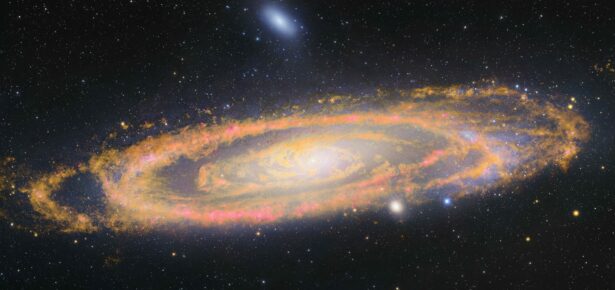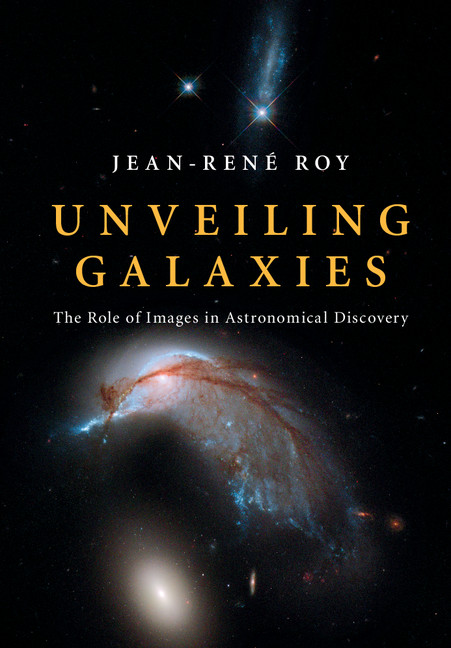
In 1924, American astronomer Edwin Powell Hubble (1889-1953) established the distance of the “Great Nebula” in Andromeda, clearly placing it outside the limits of our Milky Way. All of a sudden, the observable universe had just expanded by at least a million times.
During beautiful evenings of late summer and autumn, you can observe in the constellation Andromeda what appears through binoculars as a small diffuse object. From a place free of light pollution, you can even see this strange object with the naked eye. The ancients had noted this. In his magnificent Book of the Fixed Stars published in 964, Persian astronomer Abd al-Rahman al-Sūfī (903-986) of Isfahan (Iran) identified it as the Little Cloud. In 1612, German mathematician Simon Marius became the first to observe the object using a telescope; he describes it as “the light of a candle shining through a horn, seen from a distance.” The Little Cloud is well known today, it is the Andromeda Galaxy.
French astronomer Charles Messier (1730-1817) was a comet hunter. He had listed the Little Cloud in his catalog as number 31. Messier warned that if one were looking for new comets, Messier 31 should not be confused with a comet. At 2.5 million light years, it is the most distant object that can be seen with the naked eye.
Hubble cuts the Gordian knot
How did Edwin Hubble measure the distance to the Andromeda Galaxy? It was from the recognition and observation of variable giant stars of the Cepheid type, evolved stars which can be 100,000 times more luminous than the Sun. Pulsating Cepheids have a characteristic variability which makes them a reliable standard candle, that is to say they can be spotted at great distances and compared to nearby examples for which the distance has been directly established. In 1923 and 1924, Hubble succeeded in photographing Cepheids in a few “nebulae”, using the telescopes of the Mount Wilson Observatory in California; he established the distances of a few dozen of these Cepheids which he presumed were associated with Messier 31. On November 23, 1924, the New York Times reported on the discovery. The official announcement took place in Washington D.C. at the annual meeting of the American Astronomical Society in late December. Hubble reported his results in two very brief articles at the beginning of 1925: he placed Messier 31 at least 930,000 light years from the Sun, therefore clearly outside the Milky Way [1].
Cepheids had been photographed in Messier 31 by a few astronomers as early as 1917. But it is the merit of Hubble to have clearly recognized them as such in 1924. Something can be seen several times before being discovered! Without fanfare, Hubble put an end to an age-old debate – that between the defenders of the local hypothesis of nebulae, claiming that they were located within a super Milky Way, versus that of the proponents of the extragalactic nature of the majority of nebulae.
The reason for the divergence between these two camps? For several centuries, astronomers were unable to elucidate the nature of nebulae. Were they diffuse clouds of ethereal substance or independent star systems like the Milky Way? An exact determination of their distances was a necessary step to resolve the question. We now know that a minority, like the Orion Nebula, are real gas clouds; the majority, are immense independent star systems external to our Milky Way.
Some precursors
As early as 1917, American astronomers George Ritchey (1864-1945) and Heber Curtis (1872-1942) had discovered nova type stars in a few “nebulae” including Messier 31. A nova is produced by the nuclear detonation of material ejected from a red giant star falling on its companion white dwarf. It appears at its brightest during the explosive phase, then disappears within weeks. The pattern of their variability, however, was too irregular and unpredictable to make them good standard candles. However, Ritchey and Curtis could say that if they appeared thousands of times fainter than the novae in the Milky Way, that meant they were well beyond the Milky Way.
It was at first novae that Hubble was looking for. His surprise was to observe a recurring variable star in Andromeda, one which did not disappear after a few weeks; he had first noted it as a nova. In early 1924, he determined that it obeyed the cycle of brightness variation characteristic of Cepheids. Astronomer Henrietta Leavitt (1868-1921) working at the Harvard College Observatory had established in 1912 that there was a close relationship between the luminosity and the period of variability of Cepheids in the Magellanic Clouds; the more luminous the star, the longer its period – period varying from a few days to 50. It was therefore a question of establishing the period to derive the luminosity, and from there, the distance. Like novae, Cepheids observed in nebulae appear fainter than those of the Milky Way, because they are much more distant. Having measured their periods, Hubble derived their luminosities, and by a simple rule of three, he deduced the distance to Messier 31.
Expansion of the universe in two stages
In 1952, German astronomer Walter Baade (1893-1960) identified two types of Cepheids with distinct luminosities. Hubble had observed the most luminous ones but was referring to the least luminous ones. Baade’s discovery resulted in a roughly two-fold increase in the distances initially derived by Hubble. Today the distance to the Andromeda Galaxy is established by a set of indicators at 2.5 million light years.
The mid 1920s witnessed an avalanche of discoveries and proposals which completely transformed our vision of the universe. In 1924, also 100 years ago, the young Russian physicist Alexander Friedmann (1888-1925) re-examined Albert Einstein’s equations of general relativity of 1915. Unlike Einstein’s stationary solution, Friedmann demonstrated that space-time is unstable; just like you can’t make a pencil stand on its tip, space is either contracting or expanding. Unaware of his Russian colleague, Belgian cosmologist Georges Lemaître (1894-1966) found the same solutions, but he went much further than Friedmann. In 1927, on the basis of preliminary data on the distances and speeds of a few dozen galaxies, Lemaître concluded that the universe was expanding. Then in a flash of genius, Lemaître put the expansion in reverse. In 1931, in a short publication in Nature, he asserted that everything that exists was born in an extremely small and hot quantum packet a few billion years ago. This was the “primeval atom” hypothesis, which today has become the big bang theory.
Delayed in his studies by the Great War, Hubble received his PhD from the University of Chicago in 1921; his thesis subject was “Photographic Investigations of Faint Nebulae”. Working at the Mount Wilson Observatory since 1919, Hubble had access to its two large telescopes of 1.5 m and 2.5 m. Surprisingly Hubble was not considered a good observer; his colleagues noticed, for example, that for several of his photos the focus was not optimal. He was nevertheless methodical, proud though bashful about the contributions of others. He is sometime attributed with the discovery of the expansion of the universe through work with his meticulous colleague and peerless observer Milton Humason (1891-1972). Together, they establish the systematic relation between recession velocities and distances for tens of galaxies. However, Hubble remained doubtful of the interpretation until his death. Alan Sandage (1926-2010), Hubble’s colleague for years, was categorical: Hubble never believed in the reality of expansion.
While on a large scale the expansion of the universe carries away galaxies like floating ice, gravitational attraction continues to dominate at distances of a few million light years or less. Galaxies can thus assemble in small groups or form clusters of several thousand galaxies. They can also fall on top of each other and merge. This is what will happen to the Milky Way and the Andromeda Galaxy in 4 or 5 billion years; our two spirals will collide to form a large elliptical galaxy.
Until then, we can affirm that 100 years ago we discovered the world of galaxies, its immensity and its strange dynamics. It is striking to remind ourselves that this discovery happened so recently; for example, my grandparents born just a few years before Edwin Hubble were his contemporaries!

[1] Edwin P. Hubble, “Cepheids in Spiral Nebulae”, The Observatory, 1925, vol. 48, p. 139-142; also in Popular Astronomy, 1925, vol. 33, p. 252-255.
Latest Comments
Have your say!